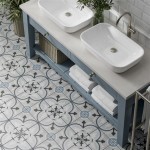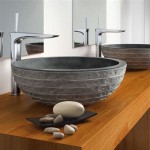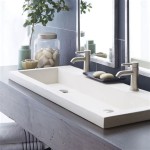Contemporary Double Sink Bathroom Vanity: A Guide to Style and Functionality
The contemporary double sink bathroom vanity has become a staple in modern home design. It offers a blend of aesthetic appeal and practical functionality, catering to the needs of households seeking optimized bathroom space and enhanced organizational capabilities. This article explores the key features, benefits, and considerations involved in choosing a contemporary double sink bathroom vanity, offering insights into materials, styles, and installation aspects.
Understanding the Appeal of Contemporary Design
Contemporary design, in the context of bathroom vanities, emphasizes clean lines, minimalist aesthetics, and the integration of modern materials. It often avoids ornate details or excessive embellishments, focusing instead on simplicity and functionality. This translates into vanities with sleek surfaces, geometric shapes, and a subdued color palette, typically incorporating neutral tones like white, gray, and black. The aim is to create a space that feels open, airy, and uncluttered, contributing to a sense of tranquility and relaxation within the bathroom.
The popularity of contemporary vanities stems from their versatility. They seamlessly integrate into a wide range of bathroom styles, serving as a focal point without overwhelming the existing decor. Furthermore, the emphasis on functionality ensures that the vanity not only looks good but also provides ample storage space and convenient access to plumbing fixtures. This combination of aesthetics and utility makes contemporary double sink bathroom vanities a desirable choice for homeowners seeking a modern and practical bathroom design.
Key Features and Considerations
Selecting the right contemporary double sink bathroom vanity requires careful consideration of several key features. Size, materials, storage capacity, and plumbing compatibility are all crucial factors that influence the overall suitability of the vanity for a particular bathroom space. By thoroughly evaluating these aspects, homeowners can ensure that their chosen vanity meets their specific needs and preferences.
Size and Dimensions: The size of the vanity should be proportionate to the dimensions of the bathroom. A vanity that is too large can overwhelm the space, making it feel cramped and uncomfortable. Conversely, a vanity that is too small may not provide adequate storage or counter space. Accurate measurements of the available space are essential to determine the optimal size of the vanity. Consider the overall layout of the bathroom, including the placement of the toilet, shower, and other fixtures, to ensure that the vanity fits seamlessly into the existing design.
Materials: The materials used in the construction of the vanity affect its durability, aesthetics, and maintenance requirements. Common materials include wood, laminate, MDF (Medium-Density Fiberboard), and stone. Solid wood is a durable and attractive option, but it can be more expensive and require more maintenance than other materials. Laminate and MDF are more affordable alternatives that offer good durability and resistance to moisture. Stone countertops, such as granite or marble, add a touch of luxury and sophistication to the vanity. However, stone can be porous and require sealing to prevent staining. The choice of material should be based on a balance of budget, aesthetic preferences, and practical considerations.
Storage Capacity: Storage is a critical aspect of any bathroom vanity. A double sink vanity should provide ample storage space for toiletries, towels, and other bathroom essentials. Consider the type and configuration of storage options offered by different vanities. Drawers provide easy access to items stored in the back, while cabinets offer more flexible storage options for larger items. Some vanities also include open shelving, which can be used to display decorative items or store frequently used items. Evaluate the storage needs of the household and choose a vanity that provides sufficient storage capacity to meet those needs.
Plumbing Compatibility: Ensure that the vanity is compatible with the existing plumbing system. The location of the pipes and drains should align with the openings in the vanity. If necessary, consult with a plumber to determine any modifications that may be required to accommodate the new vanity. Consider the type of sink and faucet that will be used with the vanity. Different sinks and faucets require different plumbing connections. Ensure that the vanity is designed to accommodate the chosen plumbing fixtures. Some vanities come pre-drilled with holes for faucets, while others require custom drilling. Consider the type of countertop material when choosing a faucet, as some materials may require specific drilling techniques. Also, remember to think about the placement of the plumbing relative to the drawers and storage space. In some instances, repositioning or choosing a specific drawer configuration may be necessary.
Exploring Styles and Design Options
Contemporary double sink bathroom vanities are available in a wide range of styles and design options to suit different tastes and bathroom layouts. Floating vanities, freestanding vanities, and corner vanities are just a few of the popular choices. Each style offers its own unique advantages and disadvantages, and the selection should be based on a combination of aesthetic preferences and practical considerations.
Floating Vanities: Floating vanities, also known as wall-mounted vanities, are suspended off the floor, creating a sense of spaciousness and modernity. This design allows for easy cleaning underneath the vanity and can make a small bathroom feel larger. Floating vanities are typically more expensive than freestanding vanities and may require professional installation to ensure proper support. The plumbing for floating vanities is often more complex, as it requires careful planning to conceal the pipes behind the wall. However, the sleek and minimalist aesthetic of floating vanities makes them a popular choice for contemporary bathrooms.
Freestanding Vanities: Freestanding vanities are the most common type of bathroom vanity. They stand on the floor and offer a wide range of design options and storage configurations. Freestanding vanities are typically easier to install than floating vanities and can be more affordable. They are available in a variety of sizes and styles to suit different bathroom layouts and design preferences. The versatility of freestanding vanities makes them a practical choice for many homeowners.
Corner Vanities: Corner vanities are designed to fit snugly into the corner of a bathroom, maximizing space utilization. This type of vanity is particularly useful in small bathrooms where space is limited. Corner vanities are available in a variety of styles and storage configurations, and they can be a stylish and functional addition to any bathroom. However, corner vanities may offer less storage space than other types of vanities, and their placement may require careful planning to ensure optimal accessibility.
In addition to these styles, design options include countertop materials, sink types, and hardware finishes. The choice of countertop material can significantly impact the overall look and feel of the vanity. Granite, marble, quartz, and solid surface materials are all popular choices, each offering its own unique advantages and disadvantages. Sink types include undermount sinks, vessel sinks, and integrated sinks. Undermount sinks are installed underneath the countertop, creating a seamless and easy-to-clean surface. Vessel sinks sit on top of the countertop, adding a touch of drama and sophistication. Integrated sinks are molded into the countertop, creating a smooth and continuous surface. The hardware finishes, such as chrome, brushed nickel, and oil-rubbed bronze, can add a finishing touch to the vanity and complement the overall bathroom design.
Installation and Maintenance
Proper installation and regular maintenance are essential to ensure the longevity and performance of a contemporary double sink bathroom vanity. Installation can be a DIY project for experienced homeowners, but it is often recommended to hire a professional plumber or contractor to ensure that the vanity is installed correctly and that all plumbing connections are properly sealed. Regular maintenance, such as cleaning and sealing, can help to prevent damage and keep the vanity looking its best.
Installation: The installation process typically involves removing the old vanity, preparing the plumbing connections, and installing the new vanity. It is crucial to carefully follow the manufacturer's instructions to ensure that the vanity is installed correctly. The vanity should be level and securely attached to the wall or floor. All plumbing connections should be properly sealed to prevent leaks. If necessary, hire a professional plumber to ensure that the installation is done correctly and that all plumbing is up to code. Incorrect installation can lead to water damage, mold growth, and other problems.
Maintenance: Regular cleaning is essential to keep the vanity looking its best. Wipe down the countertop and sink regularly with a mild soap and water solution. Avoid using harsh chemicals or abrasive cleaners, as they can damage the surface of the vanity. Stone countertops may require sealing to prevent staining. Follow the manufacturer's instructions for sealing and maintenance. Inspect the plumbing connections regularly for leaks. If you notice any leaks, repair them promptly to prevent water damage. Clean the hardware with a soft cloth to remove fingerprints and water spots. Avoid using abrasive cleaners, as they can scratch the finish of the hardware. With proper installation and regular maintenance, a contemporary double sink bathroom vanity can provide years of enjoyment and functionality.
Kb Authority Specializes In Bathroom Sink Vanities Shower Doors Kitchen Faucets And More

Eviva Lugano 72 In W X 19 D 36 H Double Bath Vanity Gray With White Acrylic Top And Integrated Sinks Evvn1700 8 72gr The Home Depot

95 Inch Modern Espresso Double Sink Bath Vanity Marble

Casa Mare Modern 72 In Gray Double Sink Bathroom Vanity With White Acrylic Top Mirror Included The Vanities Tops Department At Com

Aquamoon Granada 60 Maple Grey Double Sink Modern Bathroom Vanity With Medicine Cabinet Trends Distribution

Design Element Perfecta 72 Double Sink Bathroom Vanity Black Free Modern

Fresca Fvn31 361236aca Formosa 84 Wall Hung Double Sink Modern Bathroom Vanity With Mirrors In Acacia

60 Larvotto Light Wheat Contemporary Double Sink Bathroom Vanity Cl Chans Furniture

Aston Contemporary Floating 76 Double Sink Bathroom Vanity Matte Dar Secretbath

Eviva Lugano 84 Gray Modern Bathroom Vanity With White Integrated Acrylic Double Sink Com
Related Posts







